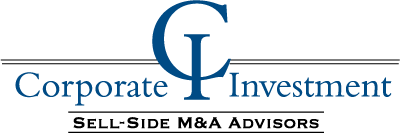In this series of articles, we are exploring a concept we often get asked about. Business owners wonder if selling a business is like selling real property investments, as many owners have some experience with real estate transactions.
In this article, we will explore how value is determined. In a subsequent article, we will compare and contrast major value drivers of a privately held business and real property investments.

What is Fair Market Value?
Whether you are buying or selling a privately held business or real property, determining the proper value has major implications. In this article, we will focus on how “fair market value” (FMV) is determined. The commonly accepted definition of FMV is:
“The amount at which property would change hands between a willing seller and a willing buyer when neither is acting under compulsion and when both have reasonable knowledge of the relevant facts.”
For both privately held businesses and real property investments, there are three basic approaches to determine FMV:
- The Asset or Cost Approach
- The Market Approach, often called comparable sales in real estate
- The Income Approach
Within each approach, there are various methodologies used. Each approach, and each method within each approach, should be evaluated and, if appropriate, applied to the property or business. The result of the evaluation will yield a range of values for the asset.
The Asset or Cost Approach
The asset or cost approach varies depending on whether the asset is a privately held business or real property. As it relates to real property, this would be the cost that an investor would incur to rebuild the asset, including the cost of land, materials, labor, and soft costs incurred to construct the real property asset.
As it relates to a business, the asset approach is the aggregation of the current market value of all the assets that are used in the operation of the business, and would include the net working capital, tangible operating assets, real property, and intangible assets, less the amount of any associated interest-bearing debt that may be assumed in a transaction. Separate appraisals may be required to determine the value of the non-financial included assets. These include the tangible property and the intangible assets, such as the goodwill, customer lists, proprietary processes, trade names and patents. If a buyer of a business is using this approach to determine how much it would cost them to start a business from scratch vs. buying an existing business (build vs. buy analysis), they would likely include any start-up costs that would be incurred to get the newly started business up to the same earning level as that of the target business.
The Market Approach
The second of the three valuation approaches is the market approach. Within this approach, there are three methods:
- The Comparative Transaction Method, which can be applied to both businesses and real property
- The Gross Revenue Multiple Method
- The Guideline Publicly Traded Company Method
The last two methods generally do not apply to real property.
The Comparative Transaction Method
The comparative transaction method uses information derived from prior reported transactions of comparative assets, or “market comps”, to determine the value of the subject property. Business sale comps are reported as a multiple of earnings, usually a multiple of earnings before interest, taxes, depreciation and amortization (EBITDA). Real property transactions are reported as price per acre and/or price per square foot or other appropriate measure, such as price per unit.
Generally, it is easier to get relevant market comps for real property assets than it is for closely held businesses. First, there are no two businesses that are exactly alike, while it is common to find similar real property assets that have sold. Second, the parties of a closely held business sale transaction usually do not disclose transaction terms to the public, while it is common to have real property sales reported to the public, either through multiple-listing services or appraisal district data. Market comps for businesses can be obtained from databases that contain private business sale transactions that been populated with contributions by M&A advisory firms on a blind basis.
The Gross Revenue Multiple Method
The gross revenue multiple method is commonly used when there is credible data on the revenue and sales price for a comparable company that has sold but information is not available regarding the company’s cash flow or income. In which case, the revenue multiple from the comparable sale can be applied to the subject company’s revenue.
The Guideline Publicly Traded Company Method
In some cases, it may be appropriate to use the guideline publicly traded company method to value a private business since the value of a public company is readily available through the reported stock transactions. Care must be used when applying this method because the ownership rights of a publicly traded are much more liquid (easier to sell through recognized public market platforms) than ownership rights of a privately held business (it takes much more time and effort to sell a closely held business). Thus, some level of “marketability” discount should be applied to the public company valuation to make it comparable to the private company.
The Income Approach
The final approach is the Income approach. Within this approach there are multiple methods.
- The Income Capitalization Method
- The Discounted Cash Flow Method
- The Excess Earnings Method (which can also be considered to be an asset-based approach method).
The Income Capitalization Method
The income capitalization method applies an appropriate capitalization rate (“cap rate”) to the annual net operating income to determine value. This method tends to be more appropriate for real property than businesses because the income streams from real property tend to be more stable than that of businesses.
The Discounted Cash Flow Method
The discounted cash flow method (DCF) estimates the value of an asset by projecting the future cash flows the asset is expected to generate and discounting those cash flows back to present value using an appropriate discount rate. This method usually also includes a terminal value of an assumed sale of the asset at a point in the future and discounting that value back to current values. The DCF method is an appropriate method for both real property and businesses, especially businesses that are experiencing a high growth rate. However, since it relies on projections and several other assumptions, it does have its drawbacks.
The Excess Earnings Method
The excess earnings method was initially developed by the Internal Revenue Service as a way to value goodwill in a business. This method uses two capitalization rates: a rate of return on tangible assets, and a rate attributable to company goodwill, as well as giving consideration to the value of the company’s financial and tangible operating assets.
Conclusion
The best approach or method to use for determining FMV depends on each unique situation and the information that is available. As mentioned earlier, once all appropriate approaches and methods are analyzed, a range of values can be determined, and professional judgment rooted in experience can be used to correlate the results into an estimate of value. Professional help should be sought to ensure fair market value is accurately determined before selling.
In upcoming articles, we will continue to compare selling investment real property and privately held businesses and the steps in the process. Next up, we will focus on value drivers and steps an owner of either a business or real property can take to increase the value of their asset. Please reach out if you have a question or topic you’d like to see covered in future articles.